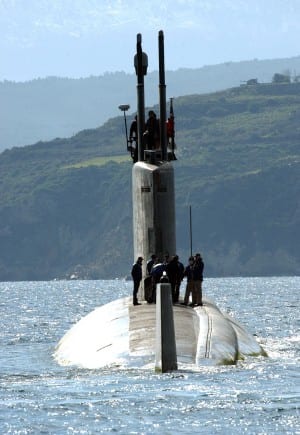This article is part of the CEO failure modes series…
I spent my first four years after college in the U.S. Navy teaching at the Naval Nuclear Power School. The military has an advantage from a management perspective, because what they do IS a matter of life and death. Because of this they understand the importance of performance in their commanding officers. The commanding officer of a naval vessel at sea is in many ways a similar position to a CEO: responsible for the performance of the ship, with nowhere to turn to if things go wrong. For this reason commanding officers are held to a high standard of responsibility.
Total responsibility at sea

U.S. Navy photo by Mr. Paul Farley (RELEASED)
One of the senior officers I met was given command of a submarine group, responsible for not one submarine but four to eight. Two weeks after this officer was put in charge, a submarine from his group grounded itself in the Pacific. The whole purpose of a submarine is to operate quietly and out of site of the enemy. Because running aground causes the submarine to be a sitting duck for an enemy attack, it is one of the worst mistakes a commander can make and is a huge black mark on his record. It was no surprise, then, when the commander of the submarine was relieved of command and forced to retire.
What might surprise you, though, was the black mark on the group commander’s record. He was not on the submarine, he had taken command only two weeks before the incident, and had never even met the sub’s commander. Despite all of this, he was still responsible for the performance of the group, and he received a black mark on his record that effectively forced him to retire without ever receiving another promotion.
Controlling risks via hubris
As CEO you are responsible for every aspect of the performance of your company, whether you are there to witness it or not. Because of this intense burden of responsibility, there is a natural human tendency to seek to control this risk. The desire for total control by a CEO can cause a whole host of unhealthy behaviors and lead to a highly dysfunctional company. I call this type of CEO failure mode the Total Control CEO.
The term micromanagement was coined in the late 70s to describe this general approach to management. While it can happen at any level in the organization, it takes its most harmful form at the CEO level. The Total Control CEO commits the sin of hubris. He believes that he can do any job in the company better than the person performing it, and if people would just follow his instructions correctly everything would go well.
The whipping mule

Photo courtesy of Wikipedia/Marc Reymond
Whenever a problem arises the Total Control CEO must find a scapegoat to maintain their air of infallibility. Their first instinct is to go to the whip and berate people over any mistake. The mental image I always think of when I see this behavior is that of a mule pulling a plow with a farmer in tow. The mule is assumed to be dumb and the job of the mule is assumed to be easy, so if the mule doesn’t behave properly you whip the mule. Mule going too slow, whip the mule. Mule going too fast, whip the mule.
No decision too small
It is often easy to identify Total Control CEOs just by observing what level of decisions requires their approval. No decision is too small to be left to others for the Total Control CEO. The color of the walls, the look of the business cards, and almost any expense must all flow through the top office.
Because this behavior is rooted in fear of making a mistake, the approval process will often become drawn out as the Total Control CEO carefully weighs the pros and cons on even the simplest issue. This has a stifling effect on the organization. First, good people want to be able to own their area and take responsibility for what they do. When the CEO is constantly dropping in and taking charge, it causes even the best employees to disengage and not take ownership of their areas. When paired with a slow decision making process, the entire organization wastes valuable time waiting for decisions that should have been made quickly at a much lower level in the organization.
Trusting your employees
The best CEOs understand that subordinates must be allowed to take ownership of their area and given the freedom to make decisions that might be different from what they would do. In my next CEO failure mode post, I’ll cover the opposite of the Total Control CEO: the Master Strategist, who is so afraid of failing that they abdicate all decision making. Then I’ll discuss how to balance the right amount of freedom with the proper level of supervision.
Previous CEO failure mode posts:
CEO Eeyore Fail: Negativity Personified
CEO Cheerleader Fail: Drawbacks of the Eternal Optimist





0 Comments
Trackbacks/Pingbacks